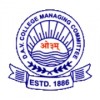

DAV Public School




10+ DAV Public School Interview Questions and Answers
Q1. Explain what will be your approach when a lesson does not work well?
I will analyze the reasons for the lesson's failure and make necessary adjustments.
Identify the specific areas where the lesson failed
Analyze the reasons for the failure
Make necessary adjustments to the lesson plan
Try different teaching methods or approaches
Seek feedback from students to understand their perspective
Re-evaluate the lesson's objectives and outcomes

Q2. Tell something about art integration in Economics,how will you going to implement it?
Art integration in Economics can enhance creativity and critical thinking skills among students.
Art can be used to explain complex economic concepts through visual aids.
Students can be encouraged to create art pieces that reflect economic issues and policies.
Art can be used to analyze and interpret economic data.
Art can be used to explore the impact of economic policies on society and culture.
Collaboration between art and economics departments can lead to interdisciplinary pr...read more

Q3. Give some Application of economics concepts in recent COVID time.
Economics concepts have been applied extensively during the COVID-19 pandemic.
Demand and supply analysis of essential goods and services
Cost-benefit analysis of lockdown measures
Impact of pandemic on global trade and supply chains
Economic stimulus packages and their effectiveness
Unemployment and income inequality
Behavioral economics in understanding public response to pandemic
Healthcare economics in vaccine distribution and prioritization

Q4. What is difference between honesty and integrity?
Honesty is being truthful and straightforward, while integrity is having strong moral principles and values.
Honesty is about telling the truth and not deceiving others.
Integrity involves doing the right thing even when no one is watching.
Honesty is more about being transparent in communication.
Integrity is about having a strong moral compass and sticking to your principles.
Both honesty and integrity are important qualities in a teacher as they set a good example for students.

Q5. what is a sonnet? What is alliteration?
A sonnet is a 14-line poem with a specific rhyme scheme and structure. Alliteration is the repetition of initial sounds in words.
A sonnet typically has 3 quatrains and a final couplet
The rhyme scheme of a sonnet varies depending on the type (e.g. Shakespearean, Petrarchan)
Alliteration can be used for emphasis or to create a musical effect
Example of alliteration: Peter Piper picked a peck of pickled peppers

Q6. Why only 32 elements in 5th group
The 5th group of the periodic table, also known as Group 15, contains 32 elements due to the electronic configuration and properties of the elements in this group.
The 5th group of the periodic table is also known as Group 15 or the nitrogen group.
Elements in this group have 5 valence electrons in their outermost shell.
The electronic configuration of elements in this group leads to similarities in their chemical properties.
Examples of elements in the 5th group include nitrogen...read more

Q7. What is ratio and proportion?????
Ratio is a comparison of two quantities, while proportion is an equation stating two ratios are equal.
Ratio is a comparison of two quantities using division.
Proportion is an equation stating that two ratios are equal.
Example of ratio: If there are 3 red balls and 5 blue balls, the ratio of red to blue balls is 3:5.
Example of proportion: 2/3 = 4/6, showing that the two ratios are equal.

Q8. What are ypur strengths?
My strengths include strong communication skills, adaptability, and creativity.
I am able to effectively communicate with students, parents, and colleagues to ensure a positive learning environment.
I am adaptable and able to adjust my teaching style to meet the needs of different students and situations.
I am creative and able to come up with engaging lesson plans and activities to keep students interested and motivated.


Q9. How to develop student interest in subject etc
To develop student interest in a subject, teachers can use engaging teaching methods, real-world examples, interactive activities, and personalized learning experiences.
Use engaging teaching methods such as hands-on activities, group projects, and multimedia presentations
Incorporate real-world examples and applications of the subject to show its relevance
Include interactive activities like games, simulations, and experiments to make learning fun and engaging
Provide personaliz...read more

Q10. What is lines and angles?????
Lines and angles are fundamental concepts in geometry that help us understand the relationships between straight lines and the angles they form.
Lines are straight figures that extend infinitely in both directions.
Angles are formed when two lines intersect at a point.
Types of angles include acute, obtuse, right, and straight angles.
Parallel lines have equal corresponding angles, while perpendicular lines form right angles.
Examples: A right angle measures 90 degrees, while a st...read more

Q11. What is simple interest????
Simple interest is a type of interest calculated only on the initial principal amount.
Simple interest is calculated as: I = P * r * t, where I is the interest, P is the principal amount, r is the interest rate, and t is the time period.
It is different from compound interest, which includes interest on both the principal amount and any accumulated interest.
Simple interest is commonly used in loans, mortgages, and savings accounts.
For example, if you borrow $1000 at an annual i...read more

Q12. What is compound interest????
Compound interest is interest calculated on the initial principal and also on the accumulated interest from previous periods.
Compound interest is calculated based on the initial principal amount and the accumulated interest from previous periods.
The formula for compound interest is A = P(1 + r/n)^(nt), where A is the amount, P is the principal, r is the annual interest rate, n is the number of times interest is compounded per year, and t is the number of years.
Compound intere...read more

Q13. Difference between eukaryotic and prokaryotic
Eukaryotic cells have a nucleus and membrane-bound organelles, while prokaryotic cells do not.
Eukaryotic cells have a true nucleus with a nuclear membrane, while prokaryotic cells have a nucleoid region where the DNA is located.
Eukaryotic cells have membrane-bound organelles like mitochondria and endoplasmic reticulum, while prokaryotic cells lack these organelles.
Eukaryotic cells are typically larger and more complex than prokaryotic cells.
Examples of eukaryotic organisms in...read more

Q14. Different between Ram and Rom?
RAM is volatile memory used for temporary storage while ROM is non-volatile memory used for permanent storage.
RAM stands for Random Access Memory while ROM stands for Read Only Memory.
RAM is used for temporary storage of data and program instructions while ROM is used for permanent storage of data and program instructions.
RAM is volatile memory which means it loses its contents when power is turned off while ROM is non-volatile memory which means it retains its contents even ...read more

Q15. What is symmetry???
Symmetry is a concept in mathematics where an object or shape is the same on both sides of a dividing line or axis.
Symmetry is when one shape becomes exactly like another if you flip, slide or turn it.
There are different types of symmetry such as reflectional symmetry, rotational symmetry, and translational symmetry.
Examples of symmetry include a circle, square, and equilateral triangle.
Symmetry can be found in nature, art, and architecture.





Top HR Questions asked in DAV Public School
Interview Process at DAV Public School

Top Interview Questions from Similar Companies









Reviews
Interviews
Salaries
Users/Month












